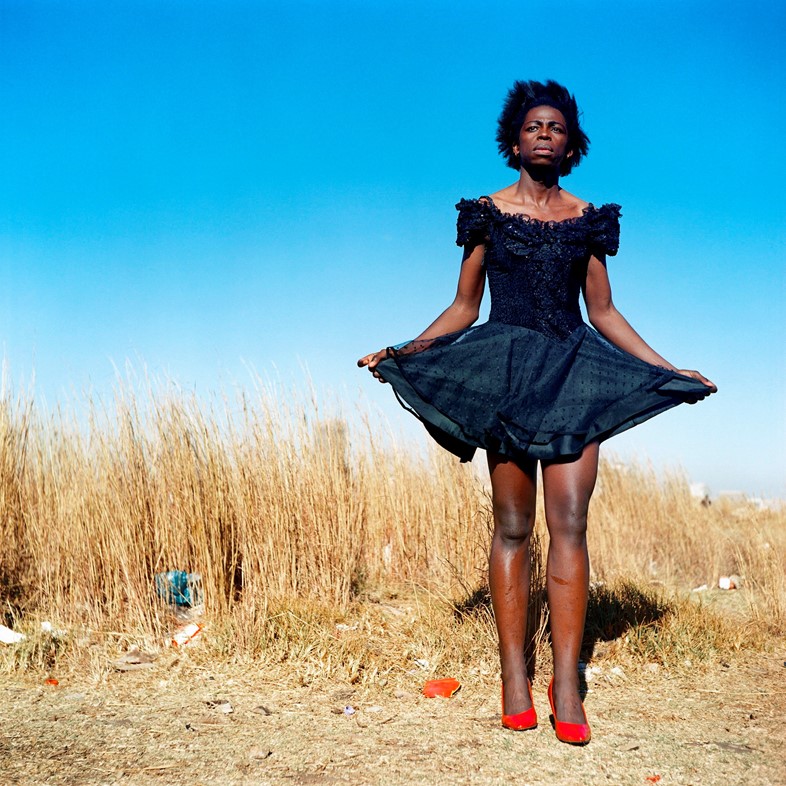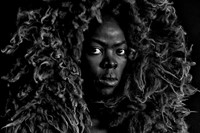As their new exhibition opens in San Francisco, Zanele Muholi talks about their powerful photos of queer survivors of hate crimes, couples in everyday moments, and self-portraits referencing history
Zanele Muholi creates potent portraits. Photographing both themselves and those within their LGBTQ+ community in South Africa, the artist speaks to both trauma and resilience; violence and beauty. The people within their photographs often return a powerful gaze directed toward the viewer, and Muholi makes playful use of props, in one well-known image depicting themselves covered in cameras. Their solo exhibition Eye Me recently opened at SFMOMA, and their travelling Tate show returns to London in updated form this summer, on June 6. At the root of all Muholi’s work is a deep connection with the community they photograph – one they are inherently part of.
“I get an opportunity to meet people through other people they trust,” Muholi tells me. “Most of the people in the projects are friends of friends. People tell their own stories when they see it’s fit for them. It’s a long process. Some people I meet and don’t photograph at all, or until I feel it’s right to do so, or they feel it is OK. We can’t force images. Sometimes when I photograph someone, they tell me a lot of stories about their family, backgrounds, or what they’re going through. Or what their family members are going through and how it affects them.”
Eye Me brings together over two decades of work, from their early series Only Half the Picture (2002-6), which documented queer survivors of hate crimes and was developed from their co-founding of The Forum for the Empowerment of Women; to Being, started in 2006 which presents couples in everyday moments, with the intention of showing a positive expression of queer love; and their recent self-portraiture work Somnyama Ngonyama (‘Hail the Dark Lioness’ in Zulu), for which the artist takes on different personas referencing moments from their own life and South African sociopolitical history.

While those they photograph have often been impacted by violence, the artist is careful to not focus purely on trauma – they also show strength and survival. Only Half the Picture is as much about what is not revealed as what is. “Was it about trauma?” they consider. “Or was it about the existence of these people and what they were resisting at that time? Or what they were willing to share? Trauma happens. People go through many stages of their lives, and those layers become part of the picture. One part belongs to the person looking at that photograph, and the other part belongs to the person who is sharing or is in the photograph.”
Muholi highlights the importance of exhibiting somewhere like SFMOMA, within the city of San Francisco which has a rich history of queer artistic expression. But considering the vast scope of Muholi’s global audience, many people viewing the images are doing so from the outside. “You feel the pain of others if you have feelings at all, or if you’re conscious-minded,” they tell me. “I try to tone it down. How do I want the world to see us? And it’s not how do I want the world to see them; I can’t sensationalise our own lives because I’m speaking from within. It’s not them and me. I try to make sure that comes with respect, responsibility. That balance is aimed at demanding the rights we never had before.”

The artist sees self-portraiture as an act of self-love, enabling a nuanced approach to both their own image and the photography of others. “I think it’s very important for us to look at ourselves before we look at other people,” they tell me. “I have my own personal take on pain. I have my own issues … I try to remember not to be in the background. What does it mean to be behind the camera when I’m exposing other people’s faces and the spaces they occupy, if I’m unable to do the same for myself? I also want to try to remember me, try to love me, to make it easier for other people to see themselves in that way.”
While there are other mediums present in the exhibition – including a sculptural bust of the artist and paintings created in bold tones that explore ideas around representation – photography has always been Muholi’s primary medium. The artist talks about the proliferation of images of white queer and trans communities and says how important it is to redress the balance in creating lasting photographs of Black LGBTQ+ lives. “There are things I wish I could speak about that I can’t write about,” they tell me. “Photography is safer, because of its accessibility. Sometimes it needs a language; sometimes it doesn’t even need a language when you get the point. I present it in the most beautiful way, even when I know it’s hard to do so. We try to normalise situations that are difficult through visuals, through photography. It’s the medium I can use to speak without any reservations.”
Eye Me by Zanele Muholi is on show at SFMOMA in San Francisco until 11 August 2024.






